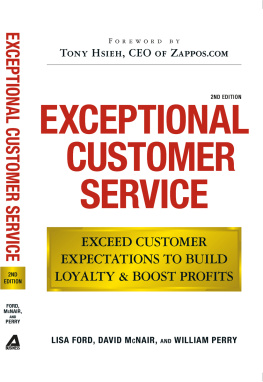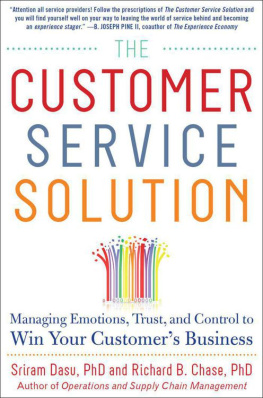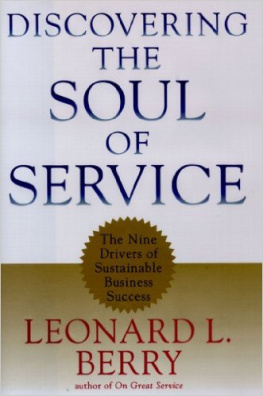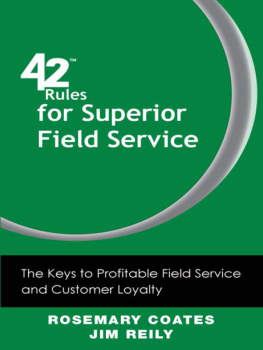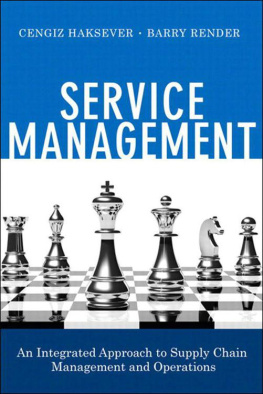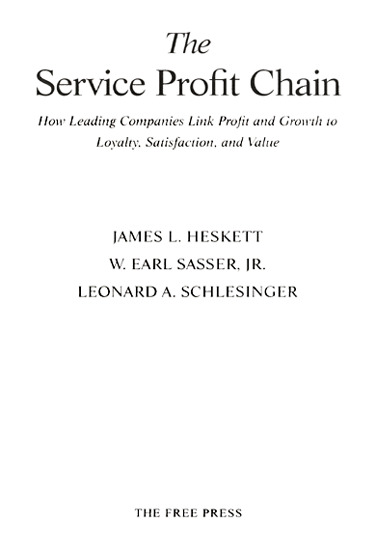W. Earl Sasser Jr. - The Service Profit Chain: How Leading Companies Link Profit and Growth to Loyalty, Satisfaction, and Value
Here you can read online W. Earl Sasser Jr. - The Service Profit Chain: How Leading Companies Link Profit and Growth to Loyalty, Satisfaction, and Value full text of the book (entire story) in english for free. Download pdf and epub, get meaning, cover and reviews about this ebook. year: 1997, publisher: Free Press, genre: Business. Description of the work, (preface) as well as reviews are available. Best literature library LitArk.com created for fans of good reading and offers a wide selection of genres:
Romance novel
Science fiction
Adventure
Detective
Science
History
Home and family
Prose
Art
Politics
Computer
Non-fiction
Religion
Business
Children
Humor
Choose a favorite category and find really read worthwhile books. Enjoy immersion in the world of imagination, feel the emotions of the characters or learn something new for yourself, make an fascinating discovery.

- Book:The Service Profit Chain: How Leading Companies Link Profit and Growth to Loyalty, Satisfaction, and Value
- Author:
- Publisher:Free Press
- Genre:
- Year:1997
- Rating:4 / 5
- Favourites:Add to favourites
- Your mark:
The Service Profit Chain: How Leading Companies Link Profit and Growth to Loyalty, Satisfaction, and Value: summary, description and annotation
We offer to read an annotation, description, summary or preface (depends on what the author of the book "The Service Profit Chain: How Leading Companies Link Profit and Growth to Loyalty, Satisfaction, and Value" wrote himself). If you haven't found the necessary information about the book — write in the comments, we will try to find it.
Why are a select few service firms better at what they do -- year in and year out -- than their competitors? For most senior managers, the profusion of anecdotal service excellence books fails to address this key question. Based on five years of painstaking research, the authors show how managers at American Express, Southwest Airlines, Banc One, Waste Management, USAA, MBNA, Intuit, British Airways, Taco Bell, Fairfield Inns, Ritz-Carlton Hotel, and the Merry Maids subsidiary of ServiceMaster employ a quantifiable set of relationships that directly links profit and growth to not only customer loyalty and satisfaction, but to employee loyalty, satisfaction, and productivity. The strongest relationships the authors discovered are those between (1) profit and customer loyalty; (2) employee loyalty and customer loyalty; and (3) employee satisfaction and customer satisfaction. Moreover, these relationships are mutually reinforcing; that is, satisfied customers contribute to employee satisfaction and vice versa.
Here, finally, is the foundation for a powerful strategic service vision, a model on which any manager can build more focused operations and marketing capabilities. For example, the authors demonstrate how, in Banc Ones operating divisions, a direct relationship between customer loyalty measured by the depth of a relationship, the number of banking services a customer utilizes, and profitability led the bank to encourage existing customers to further extend the bank services they use. Taco Bell has found that their stores in the top quadrant of customer satisfaction ratings outperform their other stores on all measures. At American Express Travel Services, offices that ticket quickly and accurately are more profitable than those which dont. With hundreds of examples like these, the authors show how to manage the customer-employee satisfaction mirror and the customer value equation to achieve a customers eye view of goods and services. They describe how companies in any service industry can (1) measure service profit chain relationships across operating units; (2) communicate the resulting self-appraisal; (3) develop a balanced scorecard of performance; (4) develop a recognitions and rewards system tied to established measures; (5) communicate results company-wide; (6) develop an internal best practice information exchange; and (7) improve overall service profit chain performance.
What difference can service profit chain management make? A lot. Between 1986 and 1995, the common stock prices of the companies studied by the authors increased 147%, nearly twice as fast as the price of the stocks of their closest competitors. The proven success and high-yielding results from these high-achieving companies will make The Service Profit Chain required reading for senior, division, and business unit managers in all service companies, as well as for students of service management.
W. Earl Sasser Jr.: author's other books
Who wrote The Service Profit Chain: How Leading Companies Link Profit and Growth to Loyalty, Satisfaction, and Value? Find out the surname, the name of the author of the book and a list of all author's works by series.

